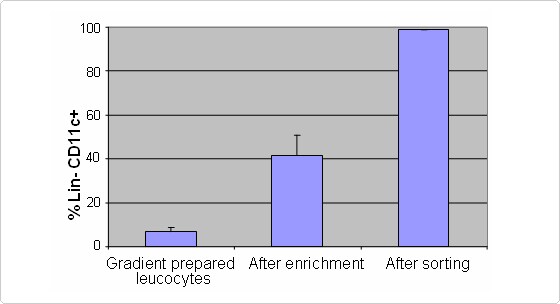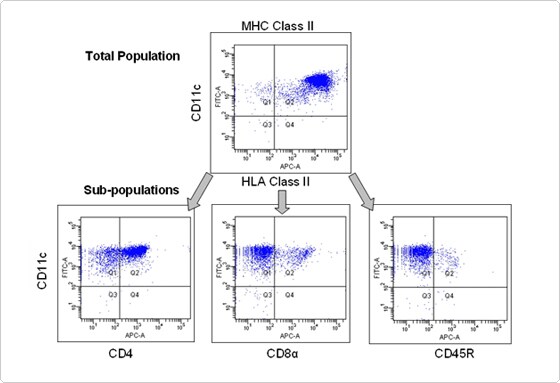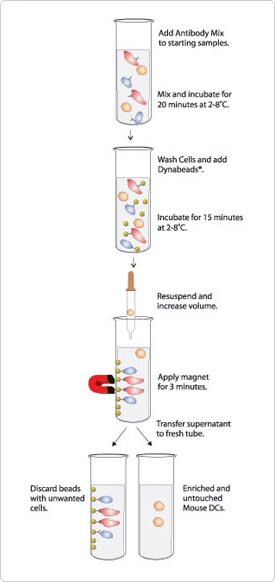Search
Mouse Dendritic Cell Enrichment & Recovery
Reduce your sorting time and increase your recovery of mouse Dendritic Cells
Increase your recovery of highly purified dendritic cell (DC) subsets using Dynabeads Mouse DC Enrichment Kit in combination with flow sorting. T cells, mIgM+ B cells, monocytes/macrophages, NK cells, erythrocytes, and most granulocytes are depleted from mouse spleen or lymph node cells to leave a bead- and antibody-free dendritic cell population.
You can expect an 80-100% recovery of the Lin- CD11c+ cells, untouched and viable (Figure 1). Enriched dendritic cells can be further isolated to any dendritic cell subpopulation by flow sorting, including dendritic cells positive for CD4, CD8a, B220, and CD19 (Figure 2).
With this gentle depletion of non-dendritic cells, your sorting time will be reduced by typically 60-90% compared to sorting only. The additional benefit is that you can reduce the need of fluorescent antibody for labeling of cells for your sorting by a factor of 6-14. Pre-enrichment saves both money and time!
Benefits of using Dynabeads Mouse DC Enrichment
- High recovery of viable dendritic cells
- Retain all dendritic cell sub-populations
- Flexibility to sort any dendritic cell sub-population
- Pool cells/tissue – easy to scale up
- Sort faster and save money

Figure 1. Percentage of Lin- CD11c+ cells in your sample after the gradient preparation, following the Dynabeads enrichment process and after the final sorting process.

How Does It Work? (Figure 3)
Run your spleen/lymph node sample through a density gradient. Add a mixture of biotinylated monoclonal antibodies (supplied) against non-dendritic cells to your sample. Then add the Dynabeads and allow them to bind to the antibody-labeled cells. After a short incubation, separate the non-dendritic cells with a magnet. Discard the bead-bound cells and use the remaining untouched, enriched cell population for further flow sorting into the dendritic cell subpopulation(s) of interest.
What Do We Offer?
The Depletion MyOne SA Dynabeads supplied are coated with streptavidin. The streptavidin will bind to the biotinylated monoclonal antibodies against mouse CD2, CD3e, CD49b, mIgM and Ter-119 supplied in the Antibody Mix. The kit will process approximately 4 x 109 total leucocytes, corresponding to 5 x 108 density gradient-prepared leucocytes.

Resources for mouse and human dendritic cell enrichment
For Research Use Only. Not for use in diagnostic procedures.